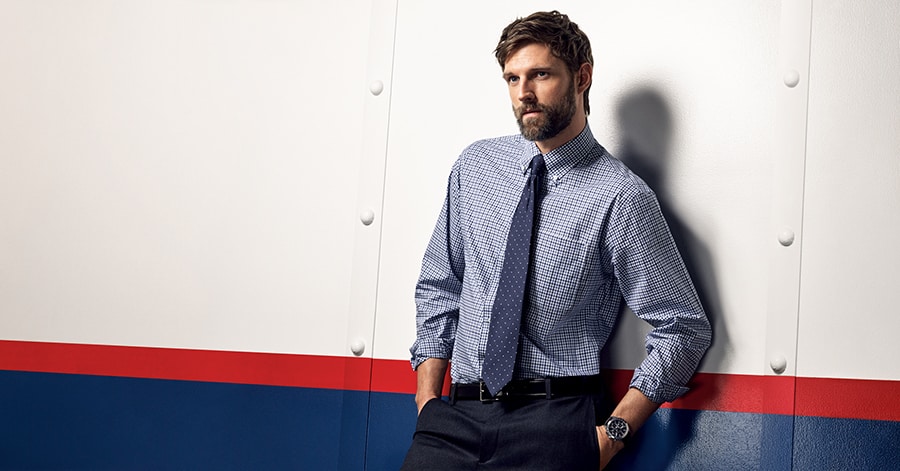INNOVATION AT LAST: PVH’S DAVID SIRKIN ON THE FUTURE OF SHIRTS AND TIES


Q: Could you comment on the new structure for furnishings at PVH? What share of the furnishings market does PVH now control?
A: We’ve combined the shirt and tie groups to create more synergies across the business and leverage the strengths of the organization. There’s now a singular vision that drives the creative process and carries through the supply chain to customer service to logistics and of course to the customer experience at retail.
As for PVH’s position in these two categories, we maintain signify can’t market share in North America. We have more than 40 percent and 50 percent of the U.S. market in dress shirts and neckwear respectively in department and chain stores.
Q: How’s the furnishings business at retail? What’s driving sales in shirts and ties these days?
A: The neckwear business has been tough all year: it’s more about the trend for men to dress more casually in the workplace. The longstanding mandate for men to sport a tie to the office is under pressure. We don’t see this trend changing in the near future, so we continue to focus on key initiatives to drive our business, including exploring innovative tie fabrics, and alternative ways for guys to express themselves sartorially.
The dress shirt business has been much more stable and healthy for us this year, driven in large part by several strong trends: fit, technology, comfort, prints. There’s tremendous innovation at so many levels, which we believe should bode well for our business into 2017.
For example, our magnetic closure shirts that we launched this fall are now in 80+ doors and are performing well against our expectations. Last fall, we launched our stretch collar shirts for Van Heusen and they now represent about 15 percent of the business; we have leveraged this technology across several other brands including Calvin Klein, Kenneth Cole, Tommy Hilfiger, Eagle, Chaps, and Geoffrey Beene. We are very pleased with the performance we have experienced in 2016, and we’re delighted that the consumer has voted for the comfort our stretch collar shirts are providing. Most importantly, we’re excited that we were able to continue to bring genuine innovation to dress shirts, since the last real innovation seen in this business was non-iron, many years ago.

Q: How important is wrinkle-free cotton in today’s dress shirt category?
A: For us, it’s approximately 35 percent of the business. Of course we also do a lot of blends for mid-tier stores so virtually everything we do is wrinkle-free or easy care. I would say approximately 98 percent of our total business involves a non-iron component.
Q: Does that mean you’re doing less in luxury?
A: No, we continue to operate in the luxury space but we’re more focused on the luxury labels we are now licensing. We also continue to do some private label in this area.
Q: Department stores in general seem to be struggling these days as they have neither the price advantage of off-price stores nor the status advantage of luxury stores. What do they need to do to jump-start sales?
A: Customer experience is really key. It’s largely about the right presentation and having well trained sales associates to communicate the brand DNA as well as highlighting what style/fit makes the most sense for a person’s body type. Communicating the various styles/fits is really the single most important factor to help consumers ultimately purchase a dress shirt. It’s easier if stores have knowledgeable sales associates on the selling floor at all times, but since that doesn’t always happen, the POS material needs to be powerful and self-explanatory.
Q: In dress shirts, what’s the ratio of regular fit to slim fit?
A: It varies by region, but I’d say it averages 55 percent regular fit to 45 percent slim-fit. (Slim fit is stronger on the west coast.) I believe the ratio should stay about the same just based on the wide variety of body types across the country. Everyone needs to feel comfortable in their clothes.

A: Today, for all types of stores, overall ticket prices on dress shirts are somewhat higher (ranging from $40-$80) but promotions have become more intense. In department stores, I’d say that the average out-the-door price is in the mid-to-high $30’s on our brands. The retailers’ private label portion of the business tends to be lower than you would expect.
Q: There are many people who think that the era of department store dominance is over: what are your thoughts?
A: There is a place for department stores but they will need to continue to evolve and reinvent themselves.
Q: How do you plan to grow the overall furnishings business at PVH?
A: We will continue to focus on low single digit type growth in this business, with an emphasis on driving innovation and differentiation for the consumer. By operating a leveraged portfolio, we’re able to ensure that we’re catering to a wide range of consumers, from those shopping at mass market to those shopping at luxury. We have the supply chain to support all tiers of distribution.



Well said, David.
David’s grasp of the market PVH serves and his eloquent comments are refreshing.